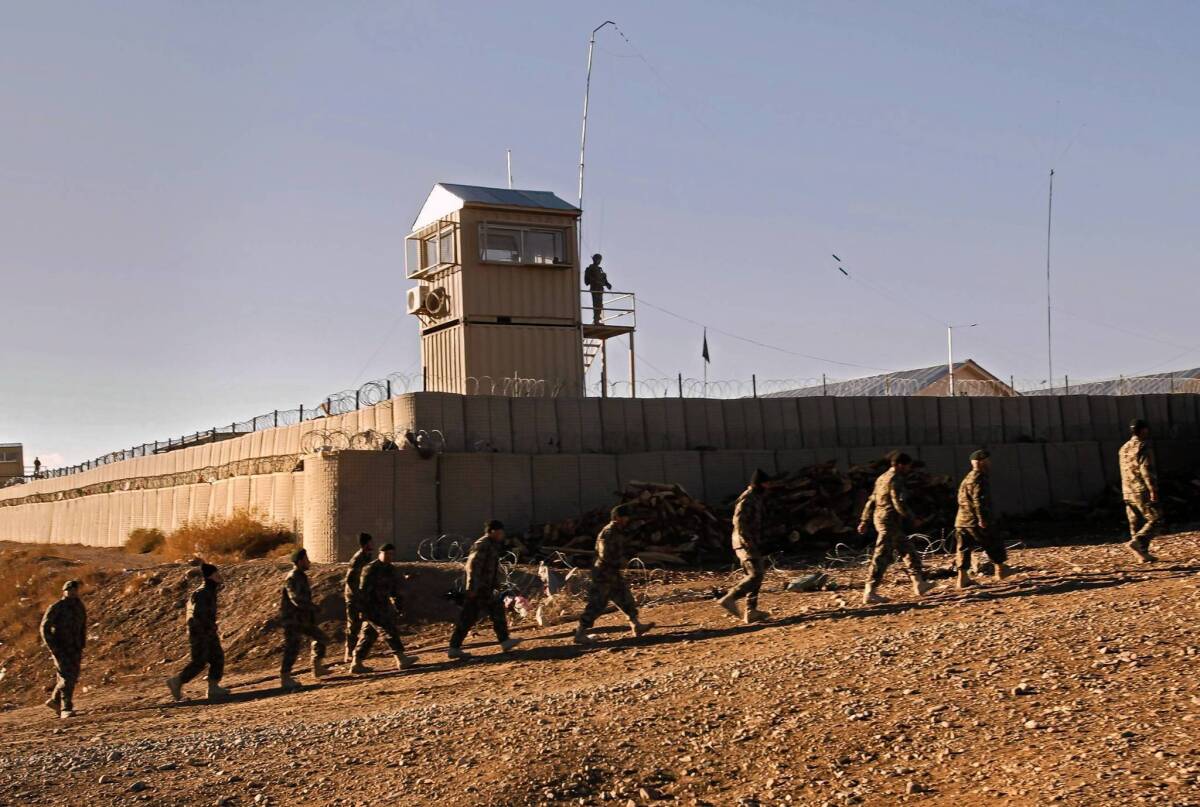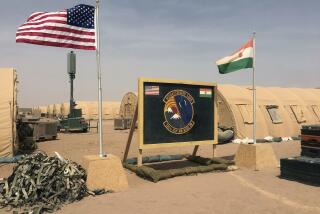U.S., Afghan officials at odds over fate of military bases

- Share via
KABUL, Afghanistan — Late last year, before leaving Forward Operating Base Tillman for the last time, U.S. troops took apart every inch of the remote outpost near the border with Pakistan, from the dirt-packed barricades to the flat-screen TVs in the intelligence center.
Mohibullah Samim, the governor of Paktika province, where the base was located, called it a waste.
“I was against dismantling it,” Samim said. “It would have been better to hand it over to the Afghan army to keep the border area safe.”
The mountaintop outpost — named for late NFL player-turned-Army Ranger Pat Tillman — was long a potent symbol of the American war effort, and military commanders worried that it would be a prime target for Islamist insurgents to seize after U.S. troops departed.
But now it is a symbol of the American withdrawal and the behind-the-scenes debate over how best to provide for the Afghan forces who will soon be fully responsible for defending their country from the Taliban militants who seek to recapture it.
As the U.S.-led military coalition begins to bring home most of its 100,000 troops and tens of billions of dollars in equipment, coalition officials are negotiating with Afghanistan over whether to raze or hand over the hundreds of checkpoints, guard towers, isolated outposts and sprawling bases that American and NATO forces built to wage the 11-year war.
In weekly meetings, Afghans have urged the coalition not to demolish any more bases, arguing that they could continue to serve as security installations or be converted into facilities the government can’t afford to build, such as schools.
But while many bases are being handed over, U.S. commanders have told Afghan officials that dozens, including Tillman, would have been too challenging to sustain given Afghanistan’s limited capabilities once most foreign troops return home by the end of 2014.
For some Afghans, the loss of these outposts highlights the uneasy reality that they will carry on the war against the Taliban with fewer facilities and far less firepower. Afghan soldiers and police have watched as bases are disassembled, no doubt realizing that coalition troops will be the next to go.
“Even if these bases are remote, at some point they served a security benefit,” said Ameen Habibi, a senior Finance Ministry official involved in the talks. “They can continue to serve that purpose.”
But coalition officials worry that Afghans will leave strategic outposts unprotected, and perhaps let them fall into enemy hands. They say they’re trying to hand over only the infrastructure that Afghan forces will be able to supply and maintain.
The Afghans’ “instinct was, at the beginning of this, ‘Turn over all your facilities to us and anything you don’t want, like Humvees or whatever, leave those behind,’” said a U.S. official who requested anonymity to discuss the talks.
“And we said that’s the wrong approach. If we were to do that you’d spend all your time, energy and money figuring out what to do with this stuff and how to run it and how to maintain it because you don’t have the capacity to do that.”
The United States has spent more than $50 billion on training, housing and equipping a force of Afghan soldiers and police officers that’s expected to reach a combined strength of 352,000. It was expected to shrink by one-third after 2014 because of concern that Afghanistan couldn’t support the cost, but NATO countries now are considering pouring in more money to sustain the larger force through 2018.
Even as their ranks grow, however, the Afghans’ logistical shortcomings persist. They rely on U.S. planes for nearly all air operations. As of June, Afghan forces had filled less than 40% of operations and maintenance jobs and lacked personnel trained to manage water, sewage and electrical systems, an audit by the U.S. Special Inspector General for Afghanistan Reconstruction reported.
U.S. officials say that some bases they’ve ceded to the Afghan government already have been abandoned or fallen into disrepair. Afghans complain that coalition forces have been too hasty to tear down facilities and in some cases have simply abandoned equipment they no longer want.
“Even if the foreigners invested $1, that shouldn’t be wasted,” said Habibi, the finance official, who co-chairs a joint NATO-Afghan commission on base closures. The group was established last year after Afghan officials found that coalition forces had dismantled an unknown number of military facilities without informing them.
“We hope, as we go forward, to make sure that no more bases are destroyed at all,” he said.
As of Feb. 1, the coalition had handed over 376 checkpoints, camps, bases and other facilities to the Afghan government while closing 243 sites. The disposition of 193 other bases — including most of the largest ones — will be determined in negotiations that could stretch into 2014. Most of the bases that survive will remain security facilities, Afghan officials said, while plans call for others to be converted to schools or restored to agricultural land.
Several bases have been shuttered along the rugged Pakistani border, where coalition forces watched — and routinely took fire from — insurgents operating on both sides of the frontier. U.S. officials say those sites, wedged into mountainsides and requiring helicopters to access, would have been extremely difficult for Afghan forces to man and equip, given their limited air assets.
One such installation was Forward Operating Base Tillman. The base was near the site of the 2004 friendly-fire incident in which Tillman was killed, less than two miles from the border. NATO forces trained Afghan soldiers and border police there, and a high-tech center served as a clearinghouse for intelligence sharing between the coalition and Pakistan.
In negotiations last year, U.S. officials convinced Afghans that the base should be mothballed.
“The biggest concern was it could only be resupplied by air,” said Col. Leonard Wells, deputy chief of staff for the coalition’s resources unit. “It’s a very contested area. It’s hard to maintain forces there if you don’t have close air support.”
Even as American forces were tearing the base down, insurgents continued to shell it. “They took fire every day,” a second U.S. official said.
But when word of the decision reached Gov. Samim, he wrote to Afghan defense officials to plead for the base to be transferred to Afghan control. He argued that local officials could have arranged for it to be supplied by road, sending a signal to insurgents that Afghan forces were serious about protecting the border.
The Afghan soldiers and border police who shared the base have since pulled back to an outpost about eight miles away, he said, leaving the border area vulnerable.
“FOB Tillman had a very positive effect on security,” Samim said.
Afghan defense officials say they don’t have a clear account of how many bases have been torn down. They cite cases in which coalition forces abandoned bases without notifying the Defense Ministry or signed over mounds of used nonlethal equipment — including air-conditioners, generators, printers and mattresses — to junior Afghan officers without the 72-hour notice they had requested.
“Your soldiers have shed their blood here for the last 11 years,” said Lt. Gen. Azizuddin Yousofzai, deputy assistant defense minister for acquisition, technology and logistics. “We would like them to be patient for three more days so this transfer process is more transparent.”
One night last fall in Kunar province, while villagers slept, U.S. troops pulled out of a base near the border hamlet of Pashangar, leaving behind 40 civilian vehicles, six generators, four buildings and several shipping containers that had housed offices and barracks, said the district governor, Gul Zaman. The families who had leased the land to the military claimed the vehicles and moved into the buildings, which Zaman said had nicer latrines and kitchens than in most of his district.
“The families are happy … but this was not a logical decision,” Zaman said by phone. He worried that Taliban insurgents would step up attacks in the area if Afghan forces weren’t posted there.
“The foreigners spent millions to build the base, but in the end the Afghan government didn’t benefit at all.”
More to Read
Sign up for Essential California
The most important California stories and recommendations in your inbox every morning.
You may occasionally receive promotional content from the Los Angeles Times.














